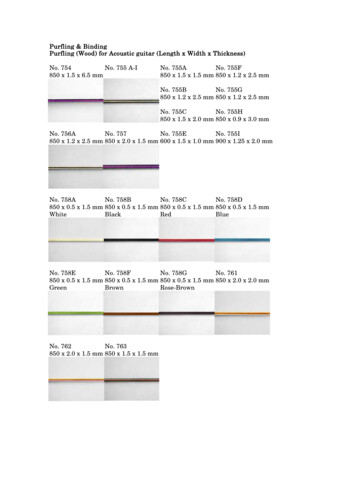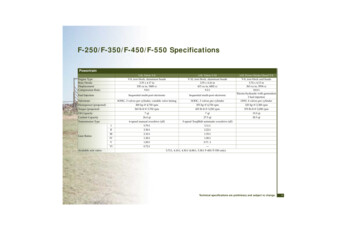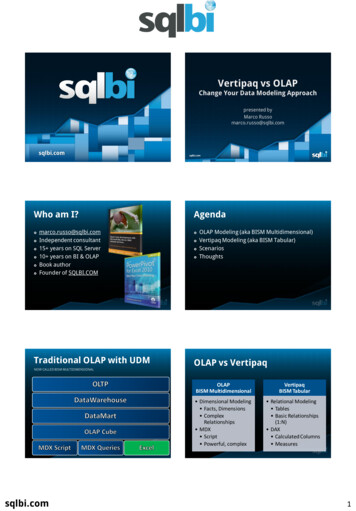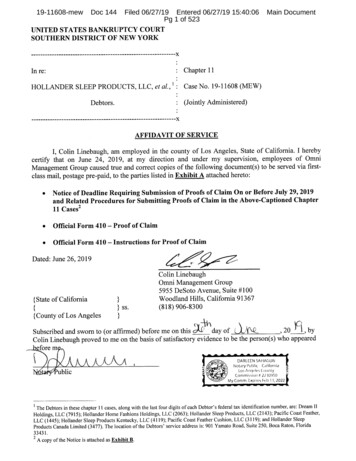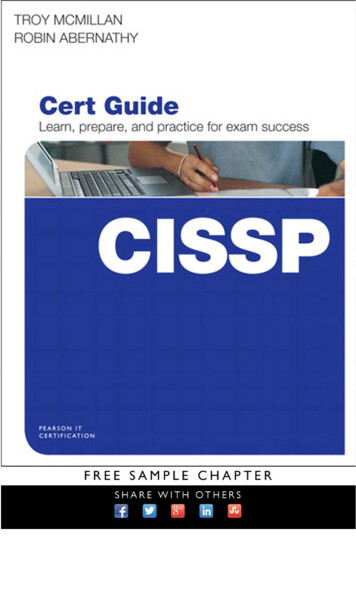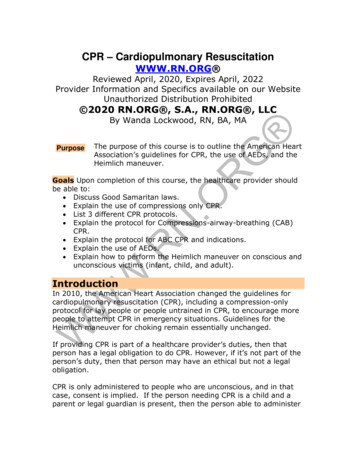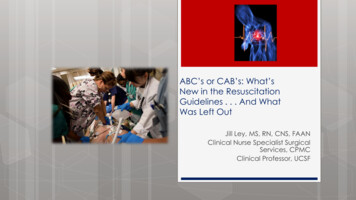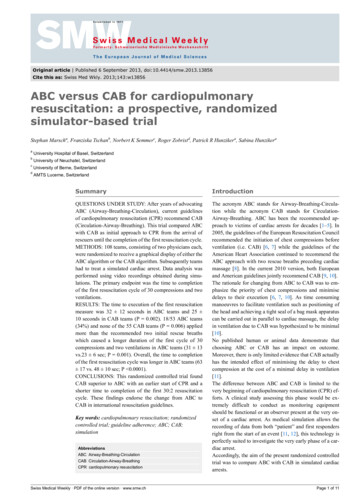
Transcription
Original article Published 6 September 2013, doi:10.4414/smw.2013.13856Cite this as: Swiss Med Wkly. 2013;143:w13856ABC versus CAB for cardiopulmonaryresuscitation: a prospective, randomizedsimulator-based trialStephan Marscha, Franziska Tschanb, Norbert K Semmerc, Roger Zobristd, Patrick R Hunzikera, Sabina HunzikeraaUniversity Hospital of Basel, SwitzerlandbUniversity of Neuchatel, SwitzerlandcUniversity of Berne, SwitzerlanddAMTS Lucerne, SwitzerlandSummaryIntroductionQUESTIONS UNDER STUDY: After years of advocatingABC (Airway-Breathing-Circulation), current guidelinesof cardiopulmonary resuscitation (CPR) recommend CAB(Circulation-Airway-Breathing). This trial compared ABCwith CAB as initial approach to CPR from the arrival ofrescuers until the completion of the first resuscitation cycle.METHODS: 108 teams, consisting of two physicians each,were randomized to receive a graphical display of either theABC algorithm or the CAB algorithm. Subsequently teamshad to treat a simulated cardiac arrest. Data analysis wasperformed using video recordings obtained during simulations. The primary endpoint was the time to completionof the first resuscitation cycle of 30 compressions and twoventilations.RESULTS: The time to execution of the first resuscitationmeasure was 32 12 seconds in ABC teams and 25 10 seconds in CAB teams (P 0.002). 18/53 ABC teams(34%) and none of the 55 CAB teams (P 0.006) appliedmore than the recommended two initial rescue breathswhich caused a longer duration of the first cycle of 30compressions and two ventilations in ABC teams (31 13vs.23 6 sec; P 0.001). Overall, the time to completionof the first resuscitation cycle was longer in ABC teams (63 17 vs. 48 10 sec; P 0.0001).CONCLUSIONS: This randomized controlled trial foundCAB superior to ABC with an earlier start of CPR and ashorter time to completion of the first 30:2 resuscitationcycle. These findings endorse the change from ABC toCAB in international resuscitation guidelines.The acronym ABC stands for Airway-Breathing-Circulation while the acronym CAB stands for CirculationAirway-Breathing. ABC has been the recommended approach to victims of cardiac arrests for decades [1–5]. In2005, the guidelines of the European Resuscitation Councilrecommended the initiation of chest compressions beforeventilation (i.e. CAB) [6, 7] while the guidelines of theAmerican Heart Association continued to recommend theABC approach with two rescue breaths preceding cardiacmassage [8]. In the current 2010 version, both Europeanand American guidelines jointly recommend CAB [9, 10].The rationale for changing from ABC to CAB was to emphasize the priority of chest compressions and minimisedelays to their execution [6, 7, 10]. As time consumingmanoeuvres to facilitate ventilation such as positioning ofthe head and achieving a tight seal of a bag mask apparatuscan be carried out in parallel to cardiac massage, the delayin ventilation due to CAB was hypothesized to be minimal[10].No published human or animal data demonstrate thatchoosing ABC or CAB has an impact on outcome.Moreover, there is only limited evidence that CAB actuallyhas the intended effect of minimising the delay to chestcompression at the cost of a minimal delay in ventilation[11].The difference between ABC and CAB is limited to thevery beginning of cardiopulmonary resuscitation (CPR) efforts. A clinical study assessing this phase would be extremely difficult to conduct as monitoring equipmentshould be functional or an observer present at the very onset of a cardiac arrest. As medical simulation allows therecording of data from both “patient” and first respondersright from the start of an event [11, 12], this technology isperfectly suited to investigate the very early phase of a cardiac arrest.Accordingly, the aim of the present randomized controlledtrial was to compare ABC with CAB in simulated cardiacarrests.Key words: cardiopulmonary resuscitation; randomizedcontrolled trial; guideline adherence; ABC; CAB;simulationAbbreviationsABC Airway-Breathing-CirculationCAB Circulation-Airway-BreathingCPR cardiopulmonary resuscitationSwiss Medical Weekly · PDF of the online version · www.smw.chPage 1 of 11
Original articleSwiss Med Wkly. 2013;143:w13856MethodsParticipantsThe study was approved by the regional ethical committeeand all participants gave written informed consent. Participants were general practitioners and hospital physiciansfrom all over Switzerland participating in workshops at thesimulator centre at the University Hospital of Basel.(corresponding to the 2005 guidelines of the European Resuscitation Council [6]). Instructions consisted of onesingle sided A4 size page and included: (1) a flowchartdisplaying the resuscitation algorithm in German language;and (2) graphical illustrations of the sequence of crucialsteps (diagnosis, cardiac massage, ventilation, and defibrillation). Flowchart and illustrations were copied from theStudy designThis is a prospective randomized controlled single-blindstudy, the participants not being aware of the purpose of thestudy. The rationale for designing this study was the lackof controlled data comparing ABC and CAB for the initial phase of CPR advocated in international resuscitationguidelines published in 2005 [6, 8]. The study was conducted from 2007 to 2010. After the publication of the 2010guidelines jointly advocating the CAB approach the investigators unanimously agreed that it would not be appropriate to draw our participants’ attention to an algorithm nolonger recommended and, therefore, decided to terminatethe study.Participants from single workshops were randomly assigned to teams of two. Each team was completed by a registered nurse. The nurse played the role of a policemancalled to the scene carrying emergency equipment including a bag mask apparatus and a defibrillator. Teams wererandomly allocated (sealed envelopes) to receive one oftwo versions of a graphical instruction of the resuscitationalgorithm (fig. 1 and 2): ABC (corresponding to the 2005guidelines of the American Heart Association [8]) or CABFigure 2Instruction of the CAB algorithm corresponding to the 2005guidelines of the European Resuscitation Council [6]. Theinstruction includes illustrations from the electronic version of the2005 guidelines of the American Heart Association [8] and theEuropean Resuscitation Council [6]. Reprint with permission of thepublishers.Figure 3Figure 1Instruction of the ABC algorithm corresponding to the 2005guidelines of the American Heart Association [8]. The instructionincludes illustrations from the electronic version of the 2005guidelines of the American Heart Association [8] and the EuropeanResuscitation Council [6]. Reprint with permission of the publishers.Swiss Medical Weekly · PDF of the online version · www.smw.chKaplan-Meier diagram displaying the probability of completing thefirst resuscitation cycle consisting of 30 compressions and 2ventilations over time. Teams were randomized to apply either ABCor CAB as initial approach to CPR. Time 0 is defined as first touchof the patient by one of the rescuers. Curves differ significantly (logrank test).Page 2 of 11
Original articleSwiss Med Wkly. 2013;143:w13856electronic versions of the 2005 resuscitation guidelines.Except for the initial measure (two rescue breaths or immediate cardiac massage) advocated after the diagnosis of cardiac arrest, both versions of the instructions were identical.ScenarioAll participants received a 15 min standardised instructionof the patient simulator (Human Patient Simulator, METI,Sarasota, FL, USA). Features of this simulator includepalpable pulses, spontaneous breathing with visiblethoracic excursion, eyes with spontaneous lid movementsand a speaker in the mannequin’s head that broadcasts thevoice of an operator to give the illusion that the “patient”can talk.Prior to the simulation the two participants allocated toform a team were led to a separate room and were briefedthat: (1) their roles were that of physicians volunteering tocover a first aid post at a large sports event; (2) the roomthey had just entered was supposed to be the physicians’resting room of the first aid post; (3) in case of a medicalemergency a policeman would arrive and lead them to thepatient; (4) the policeman would carry emergency equipment and was trained in its use; and (5) they had now thepossibility to refresh their knowledge on current algorithmsof CPR. Participants then received the graphical instructionof their allocated algorithm and were asked to read it carefully. 10 minutes after the participants had received theseinstructions the policeman entered the room and led themto the patient.The patient (simulator) was a middle aged man, dressedas a sports fan, presenting with an out of hospital unwitnessed cardiac arrest due to ventricular fibrillation. The patient was pulseless, apnoeic, had his eyes closed and didnot react to verbal commands or painful stimuli. Ventricular fibrillation could be diagnosed on the display of the defibrillator. Provided that a least one complete cycle of 30compressions and two ventilations (primary outcome) hadbeen performed, the patient converted to sinus rhythm andregained consciousness following the second defibrillation.After the simulation the participants were handed a questionnaire and asked to rate the algorithm previously received on a 10 point Likert scale with regard to: (1) the perceived helpfulness of the algorithm in handling the scenario experienced (0 completely useless, 10 extremelyhelpful); and (2) the perceived simplicity of following thealgorithm in the scenario experienced (0 extremely easy,10 extremely difficult).Data analysisData analysis was performed using video recordings obtained during simulations by two independent observers(one nurse and one physician, both working in intensivecare with regular exposition to CPR in real cases and teaching scenarios). Inter-observer differences in timing ofevents of 5 seconds were considered as agreement, andthe shorter of the two readings was used for further analysis. Inter-observer differences in timing of events of 5seconds were solved by jointly reviewing the video recordings. The first touch of the patient by one of the participantswas defined to be the starting point for the timing of allevents.Swiss Medical Weekly · PDF of the online version · www.smw.chStatisticsThe primary endpoint was the time to completion of thefirst resuscitation cycle of 30 compressions and two ventilations. We assumed that if ABC and CAB were started simultaneously and both carried out correctly, the time to completion of the first resuscitation cycle should be identical.Secondary endpoints were timings of other resuscitationevents in the initial phase (check of airway and pulse, positioning of a face mask, first defibrillation) and the results of the post-simulation questionnaire. A difference of 10 seconds in the primary outcome was considered tobe of clinical significance. In the absence of data relatingpatient outcomes with the timeliness of cardiac massage,this 10 second difference had to be arbitrarily chosen. Wehad two lines of reasoning: (1) if performed properly, a30:2 cycle lasts approximately 20 seconds so that a 10second difference represents a 50% difference; (2) in previous simulator-based studies we observed that those participants that followed the CPR algorithm exactly requiredapproximately 50 seconds to diagnose the arrest, initiateCPR and complete the first 30:2 cycle. In this context a 10second difference represents a 20% difference.A power analysis, based on data of a previous study [13]revealed that approximately 60 teams had to be studied ineach group to detect this difference with significance levelsof 0.05 and 90% power. Anticipating a 10% rate of technical difficulties or major protocol deviations we plannedto include 66 teams in each group and anticipated a studyperiod of four to five years. All data were analysed on anintention to treat basis. Data are means SD unless otherwise stated. Statistical analysis was performed using SPSS(version 19.0). Student’s t-test, chi-square test, and logrank test were applied as appropriate. A P 0.05 was considered to represent statistical significance.ResultsFigure 4Kaplan-Meier diagram displaying the probability of executing a firstinitial measure of CPR over time. Teams were randomized to applyeither ABC or CAB as initial approach to CPR. Time 0 is defined asfirst touch of the patient by one of the rescuers. Curves differsignificantly (log-rank test).Page 3 of 11
Original articleSwiss Med Wkly. 2013;143:w13856During the study period a total of 109 consecutive teamswere assessed for eligibility and all 109 teams were included in the trial. Fifty four teams were randomized toABC and 55 teams were randomized to CAB. All teams received the algorithm according to their randomization armand no protocol violation occurred. Since video recordingwas erroneously started too late to capture the initial phaseof the scenario in one team of the ABC group, this teamwas excluded from further analysis. Thus, 53 ABC teamsand 55 CAB teams were analysed. Twenty one of the 53ABC teams and 23 of the 55 CAB teams were composed oftwo general practitioners each while the remaining teamswere composed of two hospital physicians each. All hospital physicians were working in internal medicine or in asub-speciality of internal medicine. Gender distribution (36women: 70 men vs. 36 women: 74 men) and age (39 9vs.41 11 years) did not differ between the groups.Seven of the 53 teams allocated to the ABC algorithm started CPR with cardiac massage rather than rescue breaths:five of these seven teams took an active decision to startcardiac massage while experiencing technical problemswith the bag mask apparatus; one team started with cardiacmassage without apparent reason; in the remaining teama participant falsely announced that he had just performedthe rescue breaths, which prompted his partner to start cardiac massage.Figure 5Box and whisker plot displaying the number of rescue breathsapplied in the initial cycle consisting of 30 compressions and 2ventilations. Teams were randomized to use either ABC or CAB asinitial approach to CPR. Groups differ significantly (P 0.006; chisquare test). * one group; º 3 groups.Two of the 55 teams allocated to the CAB algorithm startedCPR with rescue breaths rather than with cardiac massage,both doing so without apparent reason. An additional fourCAB teams took an active decision to continue cardiacmassage during the first cycle beyond the recommended 30strokes until they had solved their technical problems withthe bag mask apparatus.Primary endpoint (fig. 3): The time to completion of thefirst resuscitation cycle of 30 compressions and two ventilations was 63 17 sec in the ABC group and 48 10 sec inthe CAB group (P 0.0001). Further analysis revealed thatthis difference was due to a combination of a later start anda longer duration of the first cycle in ABC teams (fig. 4,table 1).Secondary endpoints: 18/53 ABC teams (34%) and noneof the 55 CAB teams (P 0.006) applied more than therecommended two initial rescue breaths (fig. 5). Accordingly, the time necessary to deliver the initial rescue breathsdiffered between the groups (6 8 vs. 3 2 sec; P 0.03).As expected, this time did not differ between the 37 ABCteams delivering the recommended two rescue breaths exactly and the CAB teams (3 1 vs. 3 2 sec; P 0.88).In all subsequent cycles, all teams consistently applied twobreaths.Table 1 displays the timing of events while table 2 showsthe adherence to algorithm in the further course of resuscitation. Though teams performed, as recommended, a median of five consecutive 30:2 cycles prior to the first defibrillation and between the first and second defibrillationrespectively, there was a surprisingly high variance in thenumber of cycles performed (range 2–8, interquartile range2) with no significant difference between the groups. While49/53 ABC teams and 51/55 CAB teams consistently counted the massage strokes within a given cycle aloud, only29/53 ABC teams and 32/55 CAB teams made any statement regarding the number of cycles already performed orstill to be performed, and only 5/53 ABC teams and 6/55CAB teams systematically counted the cycles aloud.The perceived helpfulness of the algorithm was rated witha median of 8 in both groups, with an interquartile range of6-9 in the ABC group and 7-9 in the CAB group (P 0.46).The perceived simplicity of following the algorithm wasrated with a median of 3 (interquartile range 2–6) in theABC group and with a median of 2.5 (interquartile range1–5) in the CAB group (P 0.13).Table 1: Timing of events.ABC (n 53)CAB (n 55)PCheck airway (sec)8 67 80.79Check pulse (sec)16 138 60.0001Mask positioned on face (sec)36 1638 130.56Start of rescue breaths (sec)37 1543 100.005Start of cardiac massage (sec)43 1625 90.0001Start of first 30:2 cycle (sec)32 1225 100.002Length of first 30:2 cycle (sec)31 1323 60.0001End of first 30:2 cycle (sec)63 1748 100.00011st Defibrillation (sec)154 77138 430.18Data (means SD) are time intervals between time 0, defined as first touch of the patient by one of the rescuers and the occurrence of the event specified.Swiss Medical Weekly · PDF of the online version · www.smw.chPage 4 of 11
Original articleSwiss Med Wkly. 2013;143:w13856DiscussionThe present study demonstrates that starting CPR using theCAB approach leads to a shorter time interval to completethe first 30:2 resuscitation cycle than using the ABC approach. This difference is due to a combined effect of ashorter initial delay to start resuscitation measures in thefirst place and a shorter duration of the 30:2 resuscitationcycle itself.After decades of advocating ABC, the 2010 resuscitationguidelines universally advocate CAB [9, 10, 14, 15].Briefly, current guidelines recommend: 1) starting CPRwith cardiac massage (CAB), 2) performing high-qualityCPR (compression to ventilation ratio of 30:2, compressionrate of at least 100/min, compression depth of at least 5cm,full chest recoil between compressions); 3) rapid defibrillation if indicated; and 4) two minute cycles of cardiacmassage and ventilation between subsequent defibrillations[10].The change from ABC to CAB was primarily based on thetheoretical consideration that in non-asphyxial cardiac arrest ventilation is initially less important than chest compression, and that delays in, and interruptions of, chestcompressions should be minimized [6, 7, 10]. These considerations were endorsed by observational data [16–19].In addition, the accumulation of evidence that the outcomeafter CPR with chest compressions only is not worse thanafter conventional CPR may have contributed to the change[20, 21].The key findings of the present study are in agreement withthe results of a recent manikin-based study in the paediatricsettings [11] and empirically confirm two major theoretical rationale for the change from ABC to CAB in resuscitation guidelines: 1) CAB leads to a shorter delay in chestcompressions [10]; and 2) CAB leads only to a minimaldelay in ventilation, as time consuming manoeuvres necessary to allow ventilation to be performed can be carried outduring on-going chest compressions [10]. Moreover, ourfindings highlight that bag mask ventilation is a technicallydemanding task that may prove to be difficult to performcorrectly and in a timely fashion.If the ABC and CAB approach were to be carried out correctly, the time to completion of the first resuscitation cycleof 30 compressions and two ventilations should be identical. Our results demonstrate that this is not the case: theABC approach is associated with a longer delay in initiating the first resuscitation measure. Moreover, starting CPRTable 2: Adherence to algorithm after the first cycle.ABC (n 53)CAB (n 55)30 massage strokes percycle52/5354/55Chest compression rate 100/min*44/5340/552 breaths per cycle53/5355/555 cycles until 1stdefibrillation20/5316/55Defibrillation with oneshock only51/5354/555 cycles until 2nddefibrillation21/5329/55* measured in the 2nd cycle performed. No significant differencesbetween the groupsSwiss Medical Weekly · PDF of the online version · www.smw.chwith ventilation apparently carries the risk of substantiallymore than the recommended two initial rescues breaths being applied, thereby further delaying chest compressions.Although the difference between ABC and CAB consistsof a mere change in the initial sequence of two resuscitation measures, ABC is obviously more difficult to performcorrectly and in timely fashion than CAB. To the best ofour knowledge, this is the first study demonstrating that indesigning an algorithm the sequencing of events may havea profound effect on the quality of execution. Thus, thedesign of future algorithms in the medical field should beguided by empirical research on how easily the algorithmcan be followed by healthcare workers [22].We observed a remarkable variance in the adherence toindividual components of the CPR algorithm [23]. Whilealmost all teams performed the recommended 30 chestcompressions in each compression-ventilation cycle, lessthan half of the teams performed the recommended fivecompression-ventilation cycles between defibrillations.This appears to result from the fact that chest compressionswithin cycles were systematically counted aloud, whereascompression-ventilation cycles were only rarely counted.Keeping track of quantitative information poses a majorproblem for working memory, especially if the numberschange over time [24]; it therefore requires additional support, for instance by counting aloud. In the case of resuscitation, the perspective needs to change back and forthbetween attending to a lower task level (compression within cycles) and to a higher level (cycles between defibrillations). Such a change of perspective is difficult, similarto the difficulties encountered when attending to individualactions as well as the wider team context [25, 26]. In thepresent case, a solution might involve having one teammember count compressions, thus focusing on the lowerlevel, while the other one counts cycles, thus focusing onthe higher level. This observation therefore has implications for teaching medical algorithms, most notably interms of attending to team coordination as a task in its ownright [27–30].No randomised trial has ever compared ABC and CABwith regard to hard patient outcomes. As the available evidence, including the present study, almost exclusively favours CAB [16–19], it appears highly unlikely that sucha trial will be conducted in the near future. However, thecomparison of registry-based patient data from the time,where ABC and CAB were simultaneously recommendedmight reveal differences, if any, in patient outcomes.The present study included Swiss physicians. Curricula ofall Swiss medical schools encompass education in basicand advanced life support. Postgraduate training in CPRand exposition to cardiac arrests depend on speciality andinstitution chosen and may vary substantially. Trainingcourses in resuscitation including the ACLS course (advanced cardiac life support) are available on a commercialbasis. The successful completion of such courses is a prerequisite for the access to the final Swiss board exam inonly a small minority of specialtiesLimitations of simulator-based studies include the absenceof real patients. However, when performance markers suchas hands-on time and technical quality of CPR are assessed,findings in simulator-based studies show a high agreementPage 5 of 11
Original articleSwiss Med Wkly. 2013;143:w13856with findings in real cases [12, 27]. A particular strengthof simulation is the possibility of recording objective datafrom both “patient” and participants right from the start ofa cardiac arrest. Thus, simulation enabled us to investigate a topic that for a variety of medical, practical and ethical reasons is very difficult to investigate in situations involving real patients. Further strengths of the present studyinclude the sample size and the identical conditions for allparticipants.In conclusion, the present study demonstrates that the CABapproach is easier to perform correctly and in a timelyfashion than the ABC approach. CAB is associated with ashorter delay in starting resuscitation and a shorter durationof the first resuscitation cycle of 30 compressions and twoventilations. These findings endorse the change from ABCto CAB in international resuscitation guidelines.Funding / potential competing interests: This is aninvestigator driven trial without external funding. No relationshipwith industry exists that might pose a conflict of interest inconnection with the article.euvers using ABC and CAB sequences: A randomized trial. Resuscitation. 2012;83:1473–7.12 Marsch SC, Tschan F, Semmer N, Spychiger M, Breuer M, HunzikerPR. Performance of first responders in simulated cardiac arrests. CritCare Med. 2005;33:963–7.13 Hunziker S, Tschan F, Semmer NK, Zobrist R, Spychiger M, Breuer M,et al. Hands-on time during cardiopulmonary resuscitation is affectedby the process of teambuilding: a prospective randomised simulatorbased trial. BMC Emerg Med. 2009;9:3.14 Australian Resuscitation Council NZRC. Basic Life Support: Cardiopulmonary Resuscitation. ARC and NZRC Guideline 2010. EmergencyMedicine Australasia. 2011;23:259–60.15 Klemmer U. Reanimationsrichtlinien 2010. Schweizerische Arztezeitung 2011;92:62–3.16 Kern KB, Hilwig RW, Berg RA, Sanders AB, Ewy GA. Importance ofContinuous Chest Compressions During Cardiopulmonary Resuscitation: Improved Outcome During a Simulated Single Lay-Rescuer Scenario. Circulation. 2002;105:645–9.17 Assar D, Chamberlain D, Colquhoun M, Donnelly P, Handley AJ,Leaves S, et al. Randomised controlled trials of staged teaching forbasic life support: 1. Skill acquisition at bronze stage. Resuscitation.2000;45:7–15.18 Heidenreich JW, Higdon TA, Kern KB, Sanders AB, Berg RA, NieblerR, et al. Single-rescuer cardiopulmonary resuscitation: “two quickbreaths” – an oxymoron. Resuscitation. 2004;62:283–9.Correspondence: Professor Stephan Marsch, MD, Klinik fürIntensivmedizin, Universitätsspital, Spitalstrasse, CH-4031Basel, Switzerland, stephan.marsch[at]usb.ch19 Kobayashi M, Fujiwara A, Morita H, Nishimoto Y, Mishima T, NittaM, et al. A manikin-based observational study on cardiopulmonaryresuscitation skills at the Osaka Senri medical rally. Resuscitation.2008;78:333–9.References20 Cardiopulmonary resuscitation by bystanders with chest compressiononly (SOS-KANTO): an observational study. The Lancet. 369:920–6.1 Cardiopulmonary resuscitation: Statement by the ad hoc committeeon cardiopulmonary resuscitation of the division of medical sciences,national academy of sciences-national research council. JAMA.1966;198:372–9.21 Iwami T, Kawamura T, Hiraide A, Berg RA, Hayashi Y, NishiuchiT, et al. Effectiveness of Bystander-Initiated Cardiac-Only Resuscitation for Patients With Out-of-Hospital Cardiac Arrest. Circulation.2007;116:2900–7.2 Standards for cardiopulmonary resuscitation (CPR) and emergency cardiac care (ECC). JAMA. 1974;227:833–68.22 Dainty KN, Brooks SC, Morrison LJ. Are the 2010 guidelines on cardiopulmonary resuscitation lost in translation? A call for increased focuson implementation science. Resuscitation 2012.3 Standards and guidelines for Cardiopulmonary Resuscitation (CPR) andEmergency Cardiac Care (ECC). National Academy of Sciences – National Research Council. JAMA. 1986;255:2905–89.23 Osterwalder JJ, Braun D. Strengths and weaknesses of chest compression training: a preliminary retrospective study. Swiss Med Wkly.2011;141:w13221.4 Standards and guidelines for cardiopulmonary resuscitation (CPR) andemergency cardiac care (ECC). JAMA. 1980;244:453–509.24 Bogenstatter Y, Tschan F, Semmer NK, Spychiger M, Breuer M,Marsch S. How accurate is information transmitted to medical professionals joining a medical emergency? A simulator study. Hum Factors.2009;51:115–25.5 Guidelines 2000 for Cardiopulmonary Resuscitation and EmergencyCardiovascular Care. The American Heart Association in collaborationwith the International Liaison Committee on Resuscitation. Resuscitation. 2000;46:1–448.6 European Resuscitation Council Guidelines for Resuscitation 2005. Resuscitation. 2005;67S1:S1–S189.7 Handley AJ, Koster R, Monsieurs K, Perkins GD, Davies S, BossaertL. European Resuscitation Council Guidelines for Resuscitation 2005:Section 2. Adult basic life support and use of automated external defibrillators. Resuscitation. 2005; 67(Supplement 1):S7–S23.8 2005 American Heart Association Guidelines for CardiopulmonaryResuscitation and Emergency Cardiovascular Care. Circulation.2005;112:IV1–203.9 Koster RW, Baubin MA, Bossaert LL, Caballero A, Cassan P, Castr nM, et al. European Resuscitation Council Guidelines for Resuscitation2010 Section 2. Adult basic life support and use of automated externaldefibrillators. Resuscitation. 2010;81:1277–92.10 Berg RA, Hemphill R, Abella BS, Aufderheide TP, Cave DM, HazinskiMF, et al. Part 5: Adult Basic Life Support. Circulation.2010;122:S685–S705.11 Lubrano R, Cecchetti C, Bellelli E, Gentile I, Loayza Levano H, OrsiniF, et al. Comparison of times of intervention during pediatric CPR man-Swiss Medical Weekly · PDF of the online version · www.smw.ch25 Driskell JE, Salas E, Johnston J. Does stress lead to a loss of teamperspective? Group Dynamics: Theory, Research, and Practice1999;3:291–302.26 Tschan F, Vetterli M, Semmer NK, Hunziker S, Marsch SC. Activitiesduring interruptions in cardiopulmonary resuscitation: a simulatorstudy. Resuscitation. 2011;82:1419–23.27 Abella BS, Sandbo N, Vassilatos P, Alvarado JP, O’Hearn N, WigderHN, et al. Chest compression rates during cardiopulmonary resuscitation are suboptimal: a prospective study during in-hospital cardiac arrest. Circulatio
European Resuscitation Council [6]. Reprint with permission of the publishers. Figure 3 Kaplan-Meier diagram displaying the probability of completing the first resuscitation cycle consisting of 30 compressions and 2 ventilations over time. Teams were randomized to apply either ABC or CAB as
